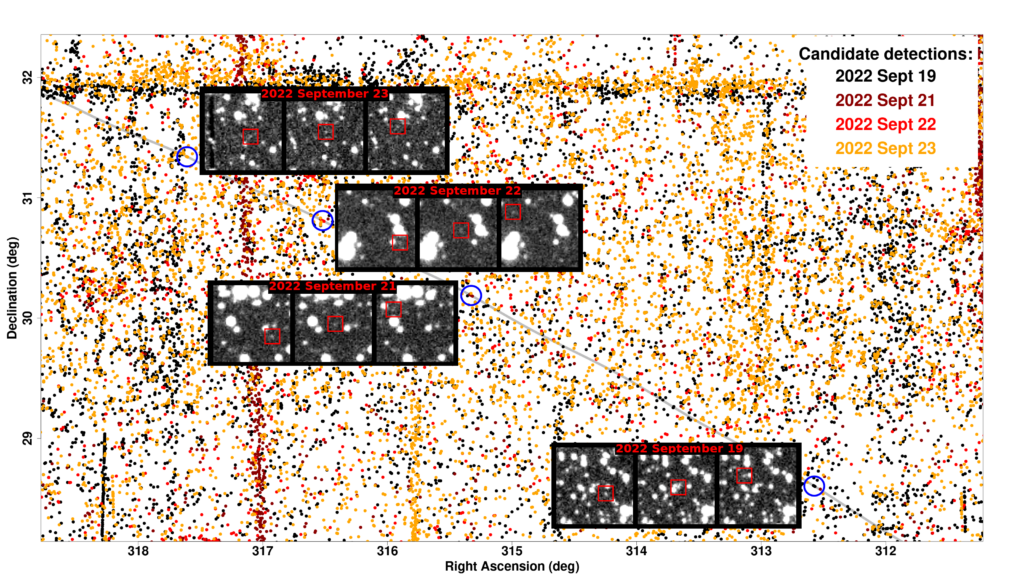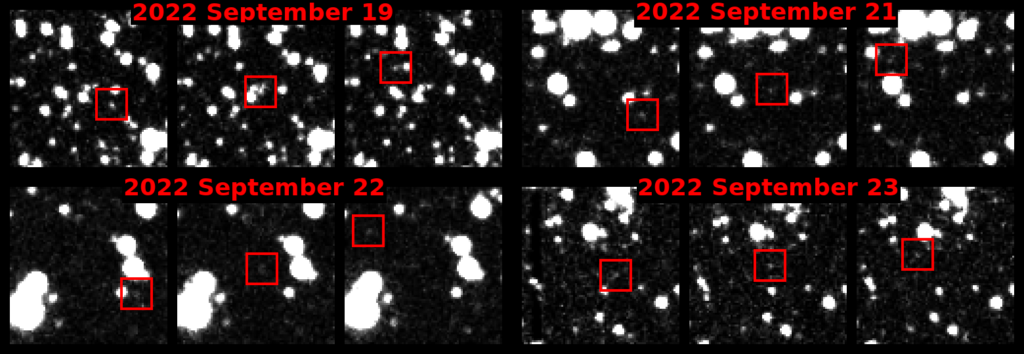
The Vera Rubin Observatory, currently being completed amid the beautiful desolation of the Chilean Andes, is scheduled to begin the most ambitious survey yet of the night sky. Starting in 2025, Rubin will make precise measurements of an estimated forty billion stars and galaxies, most currently unknown. Over ten years of planned operations, Rubin will produce 60 petabytes of data — mapping more than half the sky at a level of detail previously achieved only over small regions.
Rubin is also intended to help protect the earth by discovering thousands of potentially hazardous asteroids too faint for smaller telescopes to detect. In order to survey the cosmos with maximal efficiency, Rubin will take only two images of each patch of sky every night — while currently operating asteroid surveys take four images. Four images are needed to make sure a candidate asteroid is actually real. With only two or three sightings, an asteroid candidate is too likely to be a coincidence of glints from stars or other ‘image junk’, rather than a real object.
Using new algorithms, though, Rubin will be able to combine data from multiple nights, identifying which candidate detections must be real because they line up along a consistent orbital trajectory from night to night. Rubin’s algorithm of choice is based on HelioLinC, invented in 2018 by Smithsonian senior astrophysicist Matt Holman. At the University of Washington, Siegfried Eggl (now a professor at the University of Illinois) and I (Ari Heinze) developed a new version called HelioLinc3D, which uses orbital physics to sort through millions of junk detections and find the real asteroids moving in a consistent way.
HelioLinc3D works great in simulations, but can it discover dangerous near-Earth objects (NEOs) in real life? The most definitive demonstration would be discovering a new NEO in real data from an existing survey — and John Tonry and Larry Denneau, who lead the Hawaii-based ATLAS survey, offered ATLAS data for a test.
To make an actual discovery, HelioLinc3D would have to find something the regular ATLAS software missed — and it doesn’t miss much. I searched archival ATLAS data with HelioLinc3D for weeks, but every NEO I found had been discovered long before. Finally, though, HelioLinc3D flagged the asteroid now designated 2022 SF289. ATLAS had detected this NEO on four different nights — but the object was so faint that it was sighted in only three images on each night — never the four detections required for a single-night discovery. Only a multi-night linking algorithm such as HelioLinc3D could combine the tenuous detections to prove the object was real: the very first NEO ever discovered with the new algorithm.

Like other surveys, ATLAS makes millions of candidate asteroid detections every night — thousands even in the small patch of sky shown here. The power of HelioLinc3D is its ability to handle the mathematical complexity of an astrophysical ‘connect the dots’ game in situations like this, where we’re pushing hard to attain sensitivity to the faintest objects and necessarily picking up a lot of ‘image junk’ in the process. In the plot above, four circles highlight the detections of 2022 SF289. In each circle is a tiny string of three overlapping dots — three real detections that look superficially identical to thousands of ‘junk’ detections in the same plot. The fact that measurements from all four nights lie precisely along a consistent orbit — far more precisely than could reasonably occur through random chance — is what proves that the discovery is real.
Only a sophisticated mathematical algorithm like HelioLinc3D could prove that those sets of barely-detectable glimmers all correspond to a single giant rock hurtling through space.
Once the ATLAS observations identified by HelioLinc3D constrained the orbit of 2022 SF289, we knew where to look for some additional detections. Joachim Moeyens, also a researcher at the University of Washington and the B612 Foundation’s Asteroid Institute, identified three images from Caltech’s Zwicky Transient Facility. The Minor Planet Center, the global clearinghouse to which all asteroid discoveries are submitted, identified additional detections from the Hawaii-based Pan-STARRS survey nearly two weeks after the first ATLAS measurements, and later still from the Catalina Sky Survey’s Mt. Lemmon telescope. These additional detections refine our knowledge of 2022 SF289’s orbit and further confirm its reality.

It turns out that 2022 SF289 isn’t just a near-Earth asteroid, it’s a particularly large one (estimated diameter 600 feet) that comes close enough to Earth to be officially designated as a potentially hazardous asteroid, one of about 2350 currently known. It comes within 190,000 miles — less than the distance to the moon — of Earth’s orbit, but 2022 SF289 won’t impact Earth in the foreseeable future. That’s a good thing, since it would explode violently enough to destroy multiple cities if it struck a populated area. The discovery of 2022 SF289 proves that HelioLinc3D can discover potentially hazardous asteroids — not just in simulations but in the real Universe. It’s the strongest possible demonstration that the Vera Rubin Observatory will fulfill its promise of discovering and tracking thousands of new potentially hazardous asteroids. 2022 SF289’s discovery represents another step forward in the ongoing, global effort to defend our planetary home — and even though we call it a potentially hazardous asteroid, the fact that we found it should make us all feel safer.
Written by Ari Heinze
Related Press:
James Urton, UW News – New algorithm ensnares its first ‘potentially hazardous’ asteroid
Robin George Andrews, New York Times – Killer Asteroid-Spotting Software Could Help Save the World